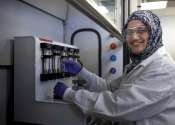News sustainable plant-derived plastic to aid organ research
Dr. Maïwenn Kersaudy-Kerhoas and Alfredo Ongaro from the Institute of Biological Chemistry, Biophysics and Bioengineering have worked with industry partners to create the first Organ-On-Chip technology that uses Polylactic ...









